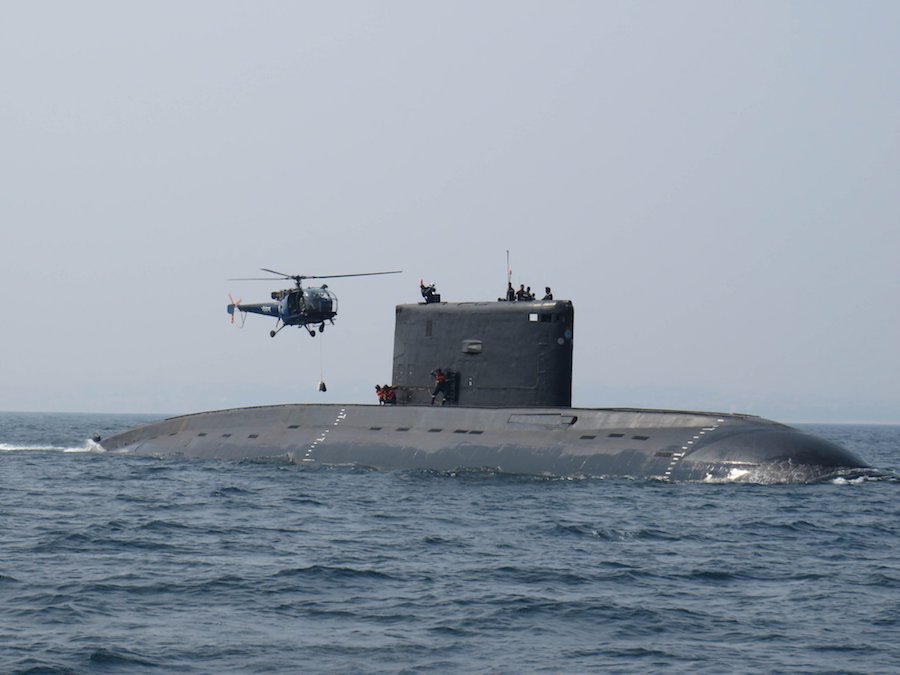The Indian navy scrambled its submarine for surveillance, and seemingly, deterrence missions during the Indo-Pak crises that ensued Pulwama attacks. Their principal aim was to target Pakistan Maritime interests while denying Pakistan Navy the liberty of action. The bid failed as India was unable to maintain forward offensive posture. What would have been the Indian undersea lethality, turned out to be vincibility of its submarines! Indian Navy Submarine Kalvari, while patrolling off Pakistani waters, was detected by P3C Orion aircraft. On scene videos and pictures, shown on the media on 4/5 March 2019, confirmed the presence of the Indian latest Scorpene class submarine, Kalvari.
Upon detection by the Pakistan naval aviation, Kalvari sailed back home where commanding officer of the submarine, along with its navigator as per reliable sources, was sacked, most probably as a punitive action of it being detected at the hands of the ‘enemy’. This episode further confirms the presence and detection of the Indian submarine off Pakistani coast and also questions the operational credibility and doctrinal clarity of the Indian navy on the deployment of its submarines. This wasn’t the first time an Indian submarine was picked up by Pakistani anti-submarine warfare aircraft. Type 209 submarine was found loitering close to Pakistani waters on 14 November 2016.
Detection of submarines, in this manner, reduces the crisis stability that has prevented both India and Pakistan from launching strikes against each other so far. Robert Powell, in his essay ‘Crisis Stability in the Nuclear Age’ written for American Political Science Review in 1989, notes that when incentives of attacking an adversary enhance (submarine destruction in this case), then the crisis stability would diminish and the probability of war increases. Detection of Indian submarines near Pakistani coast reflects an Indian design to target Pakistan’s maritime interests from the onset of conflict. Under such circumstances, Pakistan would try and detect and subsequently neutralize the Indian submarines, irrespective of the nature of its deployment, to ensure it maintains the freedom to use the seas. This ‘action-reaction chain’ would certainly lead to war between the two countries. This situation of undersea warfare necessitates that India must review:
1) Use of conventional submarines in the construct of ‘deterrence through denial’, and
2) Approach of ‘continuous at sea deterrence’.

Indian navy’s submarines had several major and minor accidents over the past decade, which include: INS Sindhughosh (collision 2008), Sindhurakshak (fire 2010 & flood 2013), Shankush (fire 2010), Sindhuratna (fire 2014), and Arihant (flood 2018). The detection of Indian submarines off Pakistan’s coast in 2016 and in 2019 was a result of Indian submarines’ technical snags where these vessels could not maintain their continuous undersea deployment. Poor maintenance standards coupled with highly flawed approach of ‘deterrence through denial’ terribly complicates operational usefulness and survivability of India’s conventional submarines. Imagining that a far flung use of these platforms truncates Pakistan navy’s operational freedom is a fairly risky proposition that the Indian navy needs to revisit in light of current realities.
With Pakistan’s technically better and operationally sound anti-submarine capability, the chances of detection of Indian submarines would be high. This means that deployment of Indian SSBN/ SSN, pursuing ‘continuous at sea deterrence’, would increase incentives for Pakistan Navy to detect and knock out these platforms very early in the conflict or a crisis situation where probability of an armed conflict could be more than usual. This would encourage Pakistan Navy to recourse to advanced anti-submarine equipment and tactics to remain superior to the Indian navy’s undersea lethality. In such a doctrinal refocus, Pakistan’s reaction to India’s ‘continuous at sea deterrence’ would erode the crisis stability thereby compelling both the states to converge to conflict. Series of accidents and detections of the Indian submarines, cumulatively, point towards operationally doubtful Indian undersea warfare capability. This strengthens the notion that the Indian deterrence could be significantly dented, which may functionally prove ineffective and unable to check Pakistan’s maritime liberty in case of a conflict. India must, therefore, reconcile with the reality that its submarines are not invincible and that their thoughtless deployment would embolden Pakistan to muster superior ASW systems/ platforms to leverage advantage of the ‘dented deterrence’. In any future Indo-Pak bilateral strain, it would be the Indian navy responsible for such egregious consequences, because of its submarines detected and becoming targets at the hands of Pakistani ASW platforms. It is substantially cautious to suggest that Indian navy must unshackle itself from the flawed theorems of ‘deterrence through denial’ and ‘continuous at sea deterrence’ and must chose a policy that helps endure peace in the Indian Ocean.





